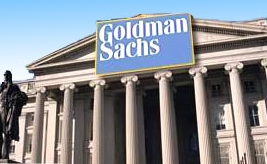GoldmanSachs高盛品牌怎么样 申请店铺
外推网助力GoldmanSachs高盛品牌出海!将品牌入驻外推网,定制GoldmanSachs高盛品牌推广信息,可以显著提高GoldmanSachs高盛产品曝光,简直是跨境电商爆单神器!目前仅需1000元/年哦~

高盛集团(GoldmanSachs),一家国际领先的投资银行,向全球提供广泛的投资、咨询和金融服务,拥有大量的多行业客户,包括私营公司,金融企业,政府机构以及个人。高盛集团成立于1869年,是全世界历史最悠久及规模最大的投资银行之一,总部位于纽约,并在东京、伦敦和香港设有分部,在23个国家拥有41个办事处。其所有运作都建立于紧密一体的全球基础上,由优秀的专家为客户提供服务。同时拥有丰富的地区市场知识和国际运作能力。
高盛公司是由德国移民马库斯·戈德曼于1869年创立的。高盛公司成立于1869年,在19世纪90年代到第一次世界大战期间,投资银行业务开始形成,但与商业银行没有区分。高盛公司在此阶段最初从事商业票据交易,创业时只有一个办公人员和一个兼职记账员。创始人马库斯·戈德曼每天沿街打折收购商人们的本票,然后在某个约定日期里由原出售本票的商人按票面金额支付现金,其中差额便是马可斯的收入。1882年,他的女婿萨缪尔·萨克斯加入了公司。1885年,马库斯·戈德曼把他的儿子亨利和LudwigDreyfuss带入了公司,并且把公司取名为高盛。公司成为了在此阶段最初从事商业票据交易的先锋,并于1896年加入了纽约证券交易所。
二十世纪初,股票包销包括首次公开募股业务使高盛成为真正的投资银行,公司1906年帮助SearRoebuck公司发行了当时规模最大的首次公开募股。高盛还成为了当时最喜欢招聘名牌商学院MBA学位学生的公司之一,这一习惯一直延续到今天。后来高盛增加贷款、外汇兑换及新兴的股票包销业务,规模虽小,却是已具雏形。而股票包销业务使高盛变成了真正的投资银行。
在1929年,高盛公司还是一个很保守的家族企业,当时公司领袖威迪奥·凯琴斯想把高盛公司由单一的票据业务发展成一个全面的投资银行。他做的第一步就是引入股票业务,成立了高盛股票交易公司,在他狂热的推动下,高盛以每日成立一家信托投资公司的速度,进入并迅速扩张类似今天互助基金的业务,股票发行量短期膨胀1亿美元。公司一度发展得非常快,股票由每股几美元,快速涨到100多美元,最后涨到了200多美元。但是好景不长,1929年的全球金融危机,华尔街股市大崩盘,使得股价一落千丈,跌到一块多钱,使公司损失了92%的原始投资,公司的声誉也在华尔街一落千丈,成为华尔街的笑柄、错误的代名词,公司濒临倒闭。这之后,继任者西德尼·文伯格一直保持着保守、稳健的经营作风。
Goldman Sachs, an international leading investment bank, provides a wide range of investment, consulting and financial services to the world, with a large number of multi industry customers, including private companies, financial enterprises, government institutions and individuals. Founded in 1869, Goldman Sachs Group is one of the oldest and largest investment banks in the world. It is headquartered in New York, with branches in Tokyo, London and Hong Kong and 41 offices in 23 countries. All of its operations are based on a close integration of the global basis, with excellent experts to provide services to customers. At the same time, it has rich regional market knowledge and international operation ability. Goldman Sachs was founded in 1869 by Markus Goldman, a German immigrant. Goldman Sachs was founded in 1869. From the 1890s to the first World War, investment banking began to take shape, but it was not distinguished from commercial banks. At this stage, Goldman Sachs initially engaged in commercial paper trading, with only one office worker and one part-time bookkeeper. Marcus Goldman, the founder, discounts people's promissory notes along the street every day, and then pays cash according to the face value of the promissory notes sold by the original businessmen on a certain date. The difference is Marcos's income. In 1882, his son-in-law, Samuel Sachs, joined the company. In 1885, Marcus Goldman brought his sons Henry and Ludwig Dreyfuss into the company and named it Goldman Sachs. The company became a pioneer in commercial paper trading at this stage and joined the New York Stock Exchange in 1896. At the beginning of the 20th century, equity underwriting including IPO made Goldman Sachs a real investment bank. In 1906, the company helped sear Roebuck issue the largest IPO at that time. Goldman also became one of the companies that liked to recruit MBA students from famous business schools at that time, a habit that continues to this day. Later, Goldman Sachs increased its loan, foreign exchange and emerging underwriting business, which was small but in its infancy. And the stock underwriting business makes Goldman Sachs a real investment bank. In 1929, Goldman Sachs was a very conservative family business. At that time, the leader of the company, vidio Cairns, wanted to develop Goldman Sachs from a single bill business to a comprehensive investment bank. The first step he did was to introduce the stock business and set up Goldman Sachs stock exchange company. Driven by his enthusiasm, Goldman Sachs entered and rapidly expanded the business similar to today's mutual fund at the speed of setting up a trust and investment company every day, with a short-term stock issuance expansion of $100 million. At one time, the company developed very fast. The stock rose rapidly from a few dollars per share to more than 100 dollars, and finally to more than 200 dollars. But the good times are not long. In 1929, the global financial crisis and the collapse of the Wall Street stock market made the stock price plummet to more than one dollar, which made the company lose 92% of its original investment. The reputation of the company also plummeted on Wall Street, becoming the laughingstock of Wall Street and the wrong synonym. The company is on the verge of bankruptcy. Since then, Sidney Weinberg, his successor, has maintained a conservative and steady management style.
本文链接: https://brand.waitui.com/c65e8b12e.html 联系电话:请联系客服添加 联系邮箱:请联系客服添加


















 浙公网安备 33011802001999号
浙公网安备 33011802001999号
